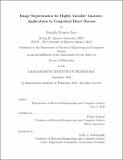Image segmentation for highly variable anatomy : applications to congenital heart disease
Author(s)
Pace, Danielle F.
Download1227705035-MIT.pdf (19.97Mb)
Other Contributors
Massachusetts Institute of Technology. Department of Electrical Engineering and Computer Science.
Advisor
Polina Golland.
Terms of use
Metadata
Show full item recordAbstract
Automated segmentation of medical images can facilitate clinical tasks in diagnosis, patient monitoring, and surgical planning. However, current methods either rely on explicit correspondence detection, or use machine learning techniques that require a large collection of fully annotated and representative images. Neither of these approaches are suitable when anatomical variability is high and labeled data is limited. In this thesis, we formulate new interactive segmentation methods and evaluate their applicability to congenital heart disease, which involves a wide range of cardiac malformations and topological changes and for which few image analysis methods have been previously developed. We begin by describing the new imaging datasets that we have created to support our research in congenital heart disease. Next, we show that image patches can be used to exploit manual segmentations made on a small set of slice planes in order to automatically segment the rest of an image, and investigate the potential of active learning to automatically solicit user input. Third, we develop an iterative segmentation model that can be accurately learned from small datasets which do not necessarily include the same pathologies as a new image to be segmented, and demonstrate that our model better generalizes to patients with the most severe heart malformations. Ultimately, the methods developed here take a step towards bringing the benefits of medical image analysis to challenging clinical applications involving large anatomical variability and small datasets.
Description
Thesis: Ph. D., Massachusetts Institute of Technology, Department of Electrical Engineering and Computer Science, September, 2020 Cataloged from student-submitted PDF of thesis. Includes bibliographical references (pages 125-144).
Date issued
2020Department
Massachusetts Institute of Technology. Department of Electrical Engineering and Computer SciencePublisher
Massachusetts Institute of Technology
Keywords
Electrical Engineering and Computer Science.